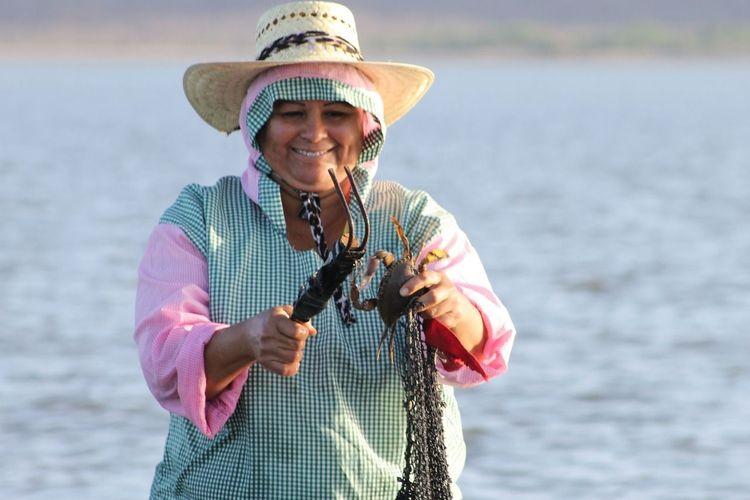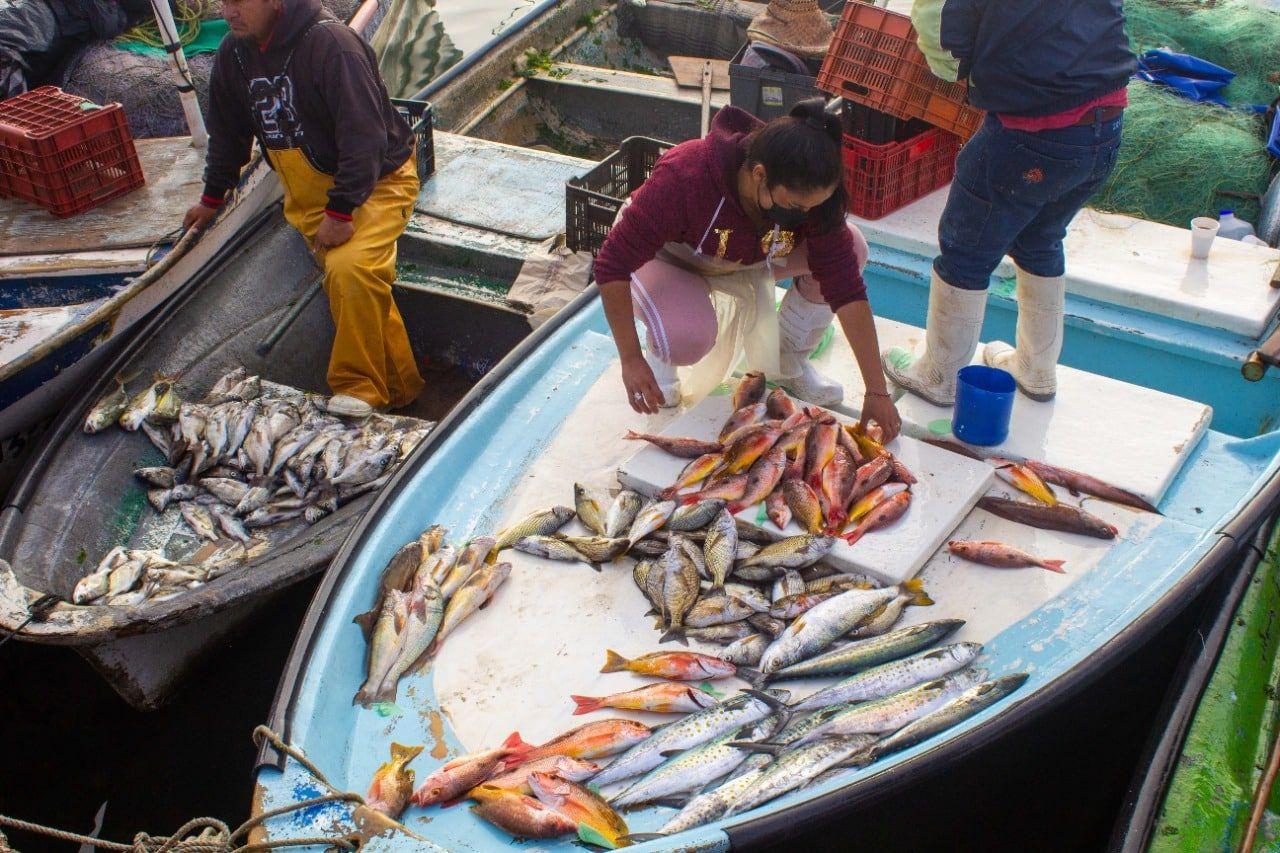Every fishing season, women from the Gulf of Santa Clara, in Sonora, prepare tables, tarps and knives to process the catch of shrimp, curvy or cannonball jellyfish that the fishermen will bring.
The work starts at five in the morning. While men head out to sea, most women are in the value chain, as all the activities they involve before, during and after capture are known.
“Here the woman is the one who helps ashore, the one who receives the fish, the one who cleans it, the one who prepares, goes and delivers. Needless to say when there is a season for aguamala (jellyfish), when there are many more women who climb the panga to go and capture,” described Monica Valenzuela, 43.
Born to a fishing family, Monica learned to clean fish and weigh shrimp since she was a child. All her work is in the fishing sector, and it was in 2016 that she decided to found the Women's Tourism Cooperative of the Upper Gulf, where she and six other colleagues are dedicated to post-harvest activities, such as cleaning, weighing, peeling and filleting the product that reaches land.
The initiative emerged in the face of economic difficulties in their homes, as a result of restrictions on fishing due to protection measures focused on the vaquita marina during the six-year term of Enrique Peña Nieto.
Three years earlier, in the same town, Miriam Pérez, now president of the Gulf Workers Cooperative Society, had decided to team up with other women in the community for the same reasons. Especially when he noticed that, despite their work, they were excluded from the agreements.
“At that time, cooperative fishermen's societies decided. We were left out because it was not considered part of the big problem that women participated in fishing outside the law, without regularization, without registration,” Pérez recalled.
In Mexico, there are around 22,000 women in fishing and aquaculture, according to the National Fisheries and Aquaculture Commission (Conapesca). 72% working in primary production and 28% in product processing.
On an international scene, of the 200 million people who work in the artisanal fishing sector, it is estimated that 50% are women.
“The problem with women's work in fishing is that their contributions are often invisible. We tend to think of the fishing sector as synonymous with going out to sea and extracting, and we don't see all the previous, subsequent and complementary activities that also contribute and that are where women work,” said Neyra Solano, gender specialist in Community and Biodiversity (COBI) A.C.
Solano explained that female participation is also undervalued because it is assumed to be an extension of household work, as part of their role as mothers, wives and daughters.
“Even fishing statistics are often based on those who fish or own boats and permits. As women do not usually have a wide presence in these spaces (due to gender roles), that keeps them relegated,” said the specialist.
(Unpaid) fishing
On May 17, 2020, Raúl Elenes Angulo, then head of Conapesca, declared at a conference that the role of women in the value chain would be recognized for the first time through Bienesca, the only federal subsidy that has been granted this six-year term to the sector.
That same year, Miriam Pérez and her co-operative colleagues were unable to access the program. The response of the Servants of the Nation in charge of the process, he recalled, was that their application did not apply because they belonged to jobs in the value chain, despite having the necessary documentation and updated records.
“We agree that most men are fishermen, but there are many women who are in the productive chains, and unfortunately people are incredulous and do not want to accept that we work in the same sectors as men, under the same values of fishing,” said Pérez.
Finally, to obtain the subsidy, some of them had to be added to the cooperatives of other fishermen in the Gulf of Santa Clara, where their procedure did proceed.
“Cultural factors sometimes influence who can access these benefits. Although at the national level there may be a slogan that (Bienesca) is given to all people, information at the community level differs in the sense that fishing is still seen as an activity for men,” explained specialist Neyra Solano.
In addition, 76.5% of Mexican women in the fishing sector work without receiving payment on a regular basis, according to the 2019 Economic Census of the National Institute of Statistics and Geography (Inegi).
In some other cases, the procedures usually take longer than expected. Like Mónica Valenzuela, who has been waiting four years for Conapesca to complete the authorization of fishing permits for her cooperative.
“The cooperative is already registered and meets the requirements, but with the permits it gets stronger... It hasn't happened because they have paperwork and they don't follow up on it. Here in the town it is recognized that women are in fishing, but obstacles remain in the procedures. They see the name on the document and put on the face of 'those who want',” he said.
Although Mónica believes that in her community, the role of women is accepted, for other localities in the Upper Gulf of California region, such as San Felipe, in Baja California, women remain on the sidelines, despite the fact that it is one of the main activities in the area.
“The reality here in San Felipe is that women's participation is happening gradually, but it's almost zero. Lately we have tried to integrate more women, who are not afraid, who are not intimidated. It's difficult,” explained Anabel Espinoza, 33.
Espinoza is part of the new generation of women who decided to start fishing in San Felipe. Belonging to a fishing family and studying law school, last summer he created a mixed cooperative focused on aquaculture, where he has sustainable projects to promote awareness in favor of an endangered species such as the totoaba.
“Sometimes we don't consider activities complementary to fishing, where there are those that are focused on sustainability and conservation. Here we find women and men who participate in fishing monitoring, beach cleaning, mangrove restoration, these other activities that contribute to management and decision-making, but are not being made visible,” added specialist Solano.

Over the years, fishing cooperatives integrated or led by women are becoming more visible. Photo: Conapesca.
Creators of sustainable alternatives
María Prodigios Piñón Castro, known only as Poli, has lived 27 years in the Gulf of Santa Clara. She is one of the 88 women who belong to the Community Administrative Monitors that promote fishing groups and the Environmental Defense Fund (EDF) in Mexico, with support from the federal government, since 2011.
The monitors were created as a tool to be able to better keep track of who is fishing, how much they are fishing and how they are fishing. Especially during curving season, due to its importance as it is within the protected area of the Upper Gulf of California Biosphere Reserve and Colorado River Delta.
“At first we weren't well regarded, really. We had to suffer a little because the fishermen are suspicious and, at first, they didn't value what we were doing with the monitoring... Nowadays we are highly respected by fishermen and people in the community,” said Poli.
However, he said that the activity is threatened by the lack of support provided by the federal government, mainly the budget.
The lack of resources and financial stability has caused the workers of the various fishing cooperatives or monitoring programs to be employed in other activities such as commerce or industrial fishing processing plants.
“Sometimes, the lack of data disaggregated by sex leads to policymaking without a gender perspective. And this can result in inadequate funding for this particular economic sector,” said Neyra Solano, an expert at COBI A.C.
The first step to making better decisions, she said, is to make visible the role of women in these spaces so that they can be included in decision-making.
In the meantime, the projects are also continuing. The Upper Gulf Women's Tourism Cooperative joined the Renatur international network to promote sustainable tourist tours; the Gulf Workers Cooperative Society has left the sea to also promote sanitation and public cleaning actions; and monitoring groups recently began a series of training to form a civil association and continue promoting women's work.



Comentarios (0)